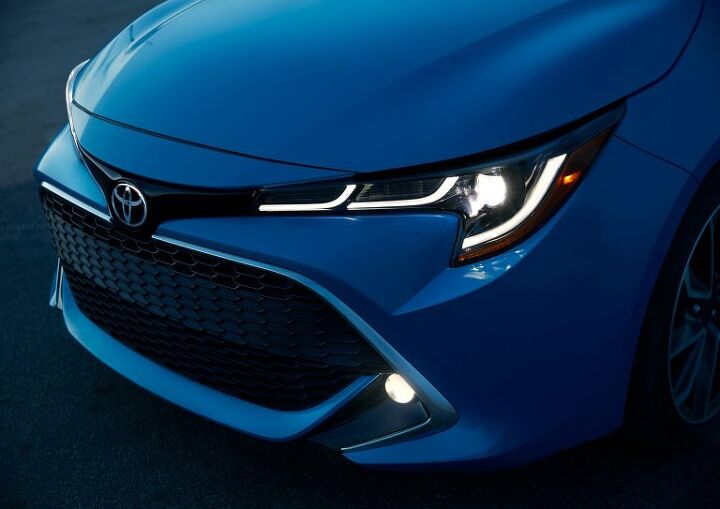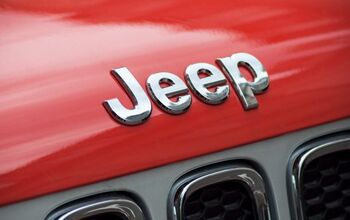Toyota Is Becoming a Software Company

Toyota announced the creation of a new holding company that will oversee its software development initiatives this week. While our default response is to gripe about the nebulous concept of “mobility companies” and the industry’s obnoxious emphasis on shifting data, we also understand that it pays to have someone on hand who knows their way around a line of code.
It wasn’t all that long go that Volkswagen was bragging about taking software seriously, only to be publicly shamed by the media when bunk programming screwed up the launch of numerous physical products. The cynical side of the brain knows this could have been avoided by ignoring unnecessary connectivity features and a potentially ill-conceived attempt to digitize the entire cabin.
We’re sympathetic to the nature of competition and the appeal “newness” has on customers. The automotive industry has seen the sea of riches amassed by tech companies harvesting data and knows which way the wind is blowing. No brand wants to be seen as technologically inferior, even if many of the newer features in modern cars aren’t really in service of anything other than marketing. Yet the “software first” mentality that has started presiding over vehicle development seems somewhat counterproductive, and Toyota may have just bought into it hook, line and sinker.
Then again, maybe it’s a great play and we’re just not seeing the big picture. So let’s dive in and see what we find.
Toyota Research Institute — Advanced Development, Inc. (TRI-AD) announced Tuesday that it will expand into a holding company divided into two operating companies. Effective January of 2021, a new entity called Woven Planet Holdings will split into Woven Core — focused on developing automated driving — and Woven Alpha — which will revolve around vehicular connectivity, navigation, and in-car applications. Likely to be the bigger money maker, at least in the short term, Alpha will also serve as the place where Toyota can test and build upon new concepts that might open the door to new sources of revenue.
It’s also tasked with handling Woven City, Toyota’s concept town that merges basically every green/connected idea you’ve ever heard of at the base of Mount Fuji. That includes “mobility as a service” in lieu of traditional vehicle ownership, smart-home devices connected to the local infrastructure, artificial intelligence wherever possible, and sustainability projects using hydrogen power.
TRI-AD CEO James Kuffner will continue leading all three companies from the institute’s home office in Tokyo. He was added to Toyota’s management board last month to showcase how serious the brand was about breaking new technological ground and evolving the company. Kuffner spoke with Automotive News in June to explain TRI-AD’s growing role at Toyota and how important software would be moving ahead.
From AN:
“Toyota has a long history of building an excellent, reliable products and hardware, but building software is something that is a new capability for many traditional automakers,” Kuffner said.
“My mission is really to create a strong software center of excellence within the Toyota group at Toyota Research Institute — Advanced Development and, working with our other partners, and create products that have both good hardware and good software together,” he said. Toyota said one goal is to create a more agile “software-first” development process for cars.
Toyota’s push to strengthen its software firepower comes as rivals make similar moves in an attempt to streamline the complicated computer systems that run their cars and have them interact more seamlessly with the vehicles’ mechanical and electronic architectures.
Volkswagen Group, for instance, said all its new models will run on a new vw.os operating system by 2025 and last year unified its fragmented information technology units into a $8 billion subsidiary called Car.Software that is tasked with developing such computer systems in-house.
We could consider some of the issues VW now faces as growing pains and hope that Toyota doesn’t find itself in a similar boat, despite intentionally walking a very familiar path. Officially, Woven is basically a rejiggering of TRI-AD with more room for investors to climb aboard various projects as they emerge. However, its overall goal remains the same — build up Toyota’s software in order to influence future hardware.
“Reorganized under the name ‘Woven,’ TRI-AD will endeavor to become the type of organization that will allow those involved to step on the accelerator in helping realize a future where people can be more happy,” Akio Toyoda, president of Toyota Motor Corporation, explained in a statement. “To make it more open and collaborative, the one thing that will purposefully be missing from these 3 new companies, Woven Planet, Woven CORE, and Woven Alpha is the ‘Toyota’ branding.”
“Regardless, these companies will clear the path for the future of Toyota, as they carry on the legacy of ‘for the happiness of others’ that Toyota has so carefully woven into its own DNA,” he concluded.
Among some of the projects outsiders can glom onto is Arene — a new automotive operating system that will allow for “programmable cars” Toyota would like to see shared throughout the industry. It’s supposed to be easily adaptable for various automotive applications, launch synced to its own cloud, and capable of frequent updates that will (hopefully) stop it from becoming stodgy and dated as the years roll on. It’s basically trying to become the macOS or Windows 10 of automotive software, but it’s still in its infancy — and this will have to be embraced by the industry at large for Toyota to achieve its ultimate goal.
[Image: Toyota]

A staunch consumer advocate tracking industry trends and regulation. Before joining TTAC, Matt spent a decade working for marketing and research firms based in NYC. Clients included several of the world’s largest automakers, global tire brands, and aftermarket part suppliers. Dissatisfied with the corporate world and resentful of having to wear suits everyday, he pivoted to writing about cars. Since then, that man has become an ardent supporter of the right-to-repair movement, been interviewed on the auto industry by national radio broadcasts, driven more rental cars than anyone ever should, participated in amateur rallying events, and received the requisite minimum training as sanctioned by the SCCA. Handy with a wrench, Matt grew up surrounded by Detroit auto workers and managed to get a pizza delivery job before he was legally eligible. He later found himself driving box trucks through Manhattan, guaranteeing future sympathy for actual truckers. He continues to conduct research pertaining to the automotive sector as an independent contractor and has since moved back to his native Michigan, closer to where the cars are born. A contrarian, Matt claims to prefer understeer — stating that front and all-wheel drive vehicles cater best to his driving style.
More by Matt Posky
Latest Car Reviews
Read moreLatest Product Reviews
Read moreRecent Comments
- Redapple2 I gave up on Honda. My 09 Accord Vs my 03. The 09s- V 6 had a slight shudder when deactivating cylinders. And the 09 did not have the 03 's electro luminescent gages. And the 09 had the most uncomfortable seats. My brother bought his 3rd and last Honda CRV. Brutal seats after 25 minutes. NOW, We are forever Toyota, Lexus, Subaru people now despite HAVING ACCESS TO gm EMPLOYEE DISCOUNT. Despite having access to the gm employee discount. Man, that is a massive statement. Wow that s bad - Under no circumstances will I have that govna crap.
- Redapple2 Front tag obscured. Rear tag - clear and sharp. Huh?
- Redapple2 I can state what NOT to buy. HK. High theft. Insurance. Unrefined NVH. Rapidly degrading interiors. HK? No way !
- Luke42 Serious answer:Now that I DD an EV, buying an EV to replace my wife’s Honda Civic is in the queue. My wife likes her Honda, she likes Apple CarPlay, and she can’t stand Elon Musk - so Tesla starts the competition with two demerit-points and Honda starts the competition with one merit-point.The Honda Prologue looked like a great candidate until Honda announced that the partnership with GM was a one-off thing and that their future EVs would be designed in-house.Now I’m more inclined toward the Blazer EV, the vehicle on which the Prologue is based. The Blazer EV and the Ultium platform won’t be orphaned by GM any time soon. But then I have to convince my wife she would like it better than her Honda Civic, and that’s a heavy lift because she doesn’t have any reason to be dissatisfied with her current car (I take care of all of the ICE-hassles for her).Since my wife’s Honda Civic is holding up well, since she likes the car, and since I take care of most of the drawbacks of drawbacks of ICE ownership for her, there’s no urgency to replace this vehicle.Honestly, if a paid-off Honda Civic is my wife’s automotive hill to die on, that’s a pretty good place to be - even though I personally have to continue dealing the hassles and expenses of ICE ownership on her behalf.My plan is simply to wait-and-see what Honda does next. Maybe they’ll introduce the perfect EV for her one day, and I’ll just go buy it.
- 2ACL I have a soft spot for high-performance, shark-nosed Lancers (I considered the less-potent Ralliart during the period in which I eventually selected my first TL SH-AWD), but it can be challenging to find a specimen that doesn't exhibit signs of abuse, and while most of the components are sufficiently universal in their function to service without manufacturer support, the SST isn't one of them. The shops that specialize in it are familiar with the failure as described by the seller and thus might be able to fix this one at a substantial savings to replacement. There's only a handful of them in the nation, however. A salvaged unit is another option, but the usual risks are magnified by similar logistical challenges to trying to save the original.I hope this is a case of the seller overvaluing the Evo market rather than still owing or having put the mods on credit. Because the best offer won't be anywhere near the current listing.


































Comments
Join the conversation
When I buy a Toyota, I don't want “mobility as a service” in lieu of traditional vehicle ownership, smart-home devices connected to the local infrastructure, or artificial intelligence. I just want a well-engineered, well-constructed, driver-friendly car that will last 250,000 miles or more when well maintained. Is my wife's 2015 Venza the last traditional Toyota? Bulletproof 4-cyl engine without forced induction or direct injection, conventional automatic transmission, starts with a key, no electronic fappery, requires no software updates or monthly fee-based service of any kind. Quiet, safe, comfortable, boring. She loves it. Oh, what a feeling.
Given the era that their infotainment suites seem to be stuck in, will they be focusing on Windows XP as a platform?